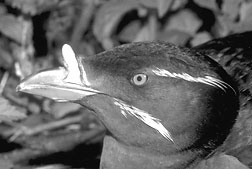Lots and Lots of Rhinos!—Spring 2006
This spring, thousands of Rhinoceros Auklets washed up along the Oregon coast. COASST volunteers Diane and Dave Bilderback found 25 of them in March on Bandon Beach. “In three years, we’ve never seen dead Rhinos on this portion of beach, so it is a new phenomenon to us.” Farther north near Yaquina Bay, Bob Loeffel reported more than 100 Rhinos over his March surveys.

One of 11 Rhinoceros Auklets (out of 12 birds total) found on a single survey of Oregon Mile 168 (J. Maloney )
Rhinoceros Auklets, so called because of the distinctive horn-like structure on their bill during the breeding season, are actually more closely related to Tufted Puffins than their smaller auklet cousins. Like most of the Alcids, Rhinos nest underground, using their heavily-clawed, powerful feet and oversized bill to tunnel out burrows.
Rhino body morphology also helps them earn a living at sea. A football-shaped body and broad, stubby wings make Rhinos good deep-diving underwater flyers like the larger Common Murre. Specializing in forage fish, Rhinos feast on a coastal cornucopia of sandlance, herring, and smelt. Fred Sharpe, a researcher from Simon Fraser University in British Columbia, has documented these quirky birds working in groups to herd fish into tight schools by blowing bubbles, while individual birds jet through and pick off their hapless prey.
A northern species, the vast majority of Rhinoceros Auklets nest in British Columbia, with many fewer colonies to the north and south. Fewer than 1,000 pairs breed in Oregon. Did we just witness the die-off of the entire Oregon population? Probably not…

A Rhinoceros Auklet complete with breeding "horn" and facial plumes (I. Jones )
Many of the Rhinoceros Auklets discovered on Oregon beaches this spring were most likely from northern colonies. Reports from Russ Bradley at PRBO Conservation Science indicate that on the Farallon Islands in California, Rhino burrowing activity is right on track. No discernible population loss there. However, other northern denizens, including Alaskan breeding species Horned Puffins and Parakeet Auklets, have also been washing up on COASST beaches. COASSTers found the program’s first seven Horned Puffins last year, and they have shown up again on the south coast of Washington this year. Parakeet Auklets—a species that breeds in the Gulf of Alaska, Aleutian Islands and Bering Sea by the hundreds of thousands—washed up on Westhaven Beach and Hobuck Beach in Washington in February. What is going on?
During winter, many Alaskan species disperse offshore and south, from Washington to California. This is why Northern Fulmars appear on our beaches in fall and winter. The fact that one of the Rhinos found near Coos Bay was a first year juvenile banded on Middleton Island in the Gulf of Alaska supports this “northern population” interpretation.
When days start to lengthen in spring, Rhinos begin their trek back up to breeding colonies in the north. In fact, COASST data show a typical up-tick of Rhinos beaching in Oregon in March, probably a reflection of this migratory massing. However, this year’s peak was up to 60 times normal!
Oiling? Fishery bycatch? Red tides? Avian Flu? What might have been the cause of this year’s Rhino die-off? Like last year’s wreck of Common Murres and Brandt’s Cormorants, the Rhinos found had no fat stores and reduced musculature, both signs of starvation. Changes in the typical pattern of winter downwelling and the transition to spring upwelling may be a factor, but without more comprehensive information on the winter distribution of seabirds and their forage fish prey along our coastline, die-offs like this spring’s Rhino event will remain a mystery.